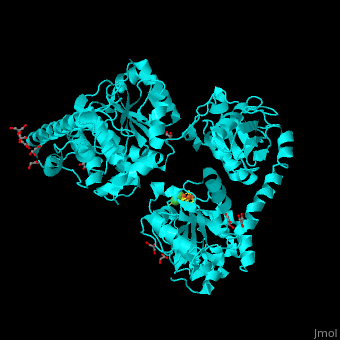Function
Acetyl-CoA synthase (ACS) is a Fe-Ni-S containing enzyme found in archae and bacteria. ACS is divided to 4 classes:
- ACS-I catalyzes the synthesis of acetyl-CoA from CoA, CO2, methyl group and 2 electrons.
- ACS-II catalyzes the reverse reaction.
- ACS-III uses pyruvate as the source of CO2 and 2 electrons to produce acetyl-CoA.
- ACS-IV catabolizes CO to CO2.
ACS can form a bifunctional entity with carbon monoxide dehydrogenase (CODH/ACS). CODH/ACS is part of the Wood-Ljungdahl pathway of carbon fixation using CO and methyl group to produce acetyl-CoA.
Structural highlights
ACS-I and ACS-II contain 5 subunits: α, β, γ, δ, ε. ACS-III is composed of 2 proteins: 2α+2β and γ+δ. ACS-IV is composed of α monomer.
- in Acetyl-CoA synthase IV subunit α from Carboxydothermus hydrogenoformans (1ru3).[1] Water molecules shown as red spheres.
3D structures of acetyl-CoA synthase
Acetyl-CoA synthase 3D structures

